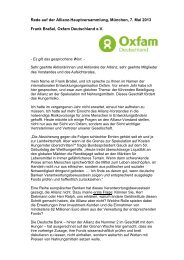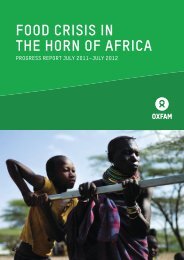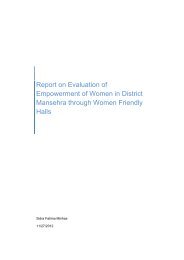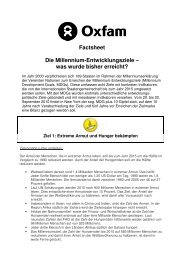No Time to Lose - Oxfam
No Time to Lose - Oxfam
No Time to Lose - Oxfam
Create successful ePaper yourself
Turn your PDF publications into a flip-book with our unique Google optimized e-Paper software.
states is described as being ‘<strong>to</strong> exert their influence, <strong>to</strong> the degree possible, <strong>to</strong> prevent and end<br />
violations’.<br />
84<br />
ICRC, above n 83, paras 24-7. The ICRC has not gone so far as <strong>to</strong> suggest that all of these steps<br />
are, as a matter of international law, necessary components of the obligation under common art<br />
1 or cus<strong>to</strong>mary international law <strong>to</strong> ensure respect for international humanitarian law.<br />
85<br />
Ibid, para 20.<br />
86<br />
Alexandra Boivin, 'Complicity and Beyond: International Law and the Transfer of Small Arms<br />
and Light Weapons' (2005) 87(859) International Review of the Red Cross 467, 479.<br />
87<br />
Foreign Operations, Export Financing and Related Programs Appropriations Acts of 2001, Pub L <strong>No</strong><br />
106-429, 114 Stat 1900 (2000) s 563; Department of Defense Appropriations Act of 2001, Pub L <strong>No</strong><br />
106-259, 114 Stat 656 (2000) s 8092(2).<br />
88<br />
As defined in The Foreign Assistance Act of 1961, Pub L <strong>No</strong> 87-195, 75 Stat 424 (1961)<br />
89<br />
Foreign Operations, Export Financing and Related Programs Appropriations Acts of 2001, Pub L <strong>No</strong><br />
106-429, 114 Stat 1900 (2000) s 563; Department of Defense Appropriations Act of 2001, Pub L <strong>No</strong><br />
106-259, 114 Stat 656 (2000) s 8092(2).<br />
90<br />
United States General Accounting Office, 'Military Training: Management and Oversight of Joint<br />
Combined Exchange Training' (Report <strong>No</strong> GAO/NSIAD-99-173, July 1999), 52-6.<br />
91<br />
Interview with senior ISAF official, Kabul, January 2011.<br />
92<br />
Council Common Position 2008/944/CFSP of 8 December 2008 Defining Common Rules Governing<br />
Control of Exports of Military Technology and Equipment [2008] OJ L 335/99.<br />
93<br />
Council of the EU, User’s Guide <strong>to</strong> Council Common Position 2008/944/CFSP Defining Common Rules<br />
Governing the Control of Exports of Military Technology and Equipment, 9241/09, 29 April 2009, 39.<br />
94<br />
Ibid 44-5.<br />
95<br />
Common Military List of the European Union [2010] OJ C 69/19, 51.<br />
96<br />
Pro<strong>to</strong>col Additional <strong>to</strong> the Geneva Conventions of 12 August 1949, and relating <strong>to</strong> the Protection of<br />
Victims of International Armed Conflicts, opened for signature 12 December 1977, 1125 UNTS 3<br />
(acceded <strong>to</strong> by Afghanistan 24 January 1983), art 87.<br />
97<br />
See German Federal Ministry of Defence, Humanitarian Law in Armed Conflicts: Manual, 1992,<br />
[211]; US Department of Defense, Department of Defense Law of War Program, Department of<br />
Defense Directive <strong>No</strong> 2311.01E, 9 May 2006, 2.<br />
98<br />
Department of the Army, US Department of Defense, Army Training and Leader Development,<br />
Army Regulation 350-1, 18 December 2009, 161 and Marie Anderson and Emily Zukauskas<br />
(eds), Operational Law Handbook (2008), 36 (regarding the obligation <strong>to</strong> prevent); and US<br />
Department of Defense, Law of War Program, above n 97, 8 (regarding the obligation <strong>to</strong> report).<br />
The obligation <strong>to</strong> prevent applies only <strong>to</strong> violations by other US soldiers, while the obligation <strong>to</strong><br />
report applies <strong>to</strong> violations by anyone.<br />
99<br />
US Department of Defense, Law of War Program, above n 97, 2.<br />
100<br />
Ibid 8.<br />
101<br />
Ibid 4.<br />
102<br />
See, for eg, Joint Doctrine and Concepts Centre, UK Ministry of Defence, The Joint Service Manual<br />
of the Law of Armed Conflict, Joint Service Publication 383, 2004, 438-440 (provides that<br />
commanders are responsible for ‘preventing violations of the law … and for taking the<br />
necessary disciplinary action’, with respect <strong>to</strong> subordinates under their effective control); and<br />
Office of the Judge Advocate General, Canadian Department of National Defence, Law of Armed<br />
Conflict, Joint Doctrine Manual B-GJ-005-104/FP-021,August 2001, 16-9 (commanders are<br />
responsible, with respect <strong>to</strong> … persons under their control, <strong>to</strong> prevent and, where necessary, <strong>to</strong><br />
suppress and <strong>to</strong> report <strong>to</strong> competent authorities, breaches of the law of armed conflict’).<br />
103<br />
Ministry of Interior, Government of the Islamic Republic of Afghanistan, ‘Afghan National<br />
Police Commitment of Promise’, available at<br />
<br />
104<br />
Email correspondence from ISAF official, Kabul, March 2011.<br />
105<br />
Government of the Islamic Republic of Afghanistan, Ministry of Interior, Code of Conduct of the<br />
Afghan National Police (Draft, February 2011).<br />
106<br />
Interview with AIHRC, Kabul, April 2011.<br />
107<br />
Government of the Islamic Republic of Afghanistan, Ministry of Interior, Afghan National Police<br />
Strategy, December 2010.<br />
108<br />
The Afghan National Army Law of Military Courts 2005 (Afghanistan).<br />
109<br />
Interview with senior ISAF official, Kabul, February 2011.<br />
110<br />
Interview with senior ISAF official, Kabul, February 2011.<br />
35






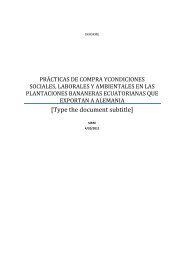
![Download: Faltposter EU-Handelspolitik [PDF 2,17MB] - Germanwatch](https://img.yumpu.com/25095854/1/190x161/download-faltposter-eu-handelspolitik-pdf-217mb-germanwatch.jpg?quality=85)
